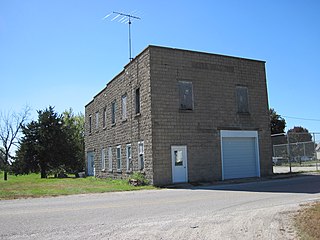History
Jordan was historically called Midway and Harmon's Switch. [2] The present name is after the Jordan River. [3] Jordan was not officially platted. [4] Jordan's population was 12 in 1902, [5] and 26 in 1925. [6]
Jordan was hit by a massive tornado on June 13, 1976. The tornado was rated an F5 by the National Weather Service, and the National Centers for Environmental Information (then called National Climatic Data Center) indicated that the damage path of the tornado was roughly 880 yards (800 m) or one-half mile (0.8 km) wide and 21 miles (34 km) long. The tornado destroyed virtually every house and business building in the community, but all residents survived. The tornado was accompanied by an F-3 anticyclonic tornado two miles to the southeast. One unusual aspect of the F5 cyclonic tornado and F3 anticyclone tornado was the simultaneous right turn made by each. [7] Dr. Ted Fujita, the originator of the Fujita tornado intensity scale, said the tornado which hit Jordan was one of the most intense and destructive he had ever studied. [8]

An anticyclonic tornado is a tornado which rotates in a clockwise direction in the Northern Hemisphere and a counterclockwise direction in the Southern Hemisphere. The term is a naming convention denoting the anomaly from normal rotation which is cyclonic in upwards of 98 percent of tornadoes. Many anticyclonic tornadoes are smaller and weaker than cyclonic tornadoes, forming from a different process, as either companion/satellite tornadoes or nonmesocyclonic tornadoes.

On March 28, 1920, a large outbreak of at least 37 tornadoes, 31 of which were significant, took place across the Midwestern and Southern United States. The tornadoes left at least 153 dead and at least 1,215 injured. Many communities and farmers alike were caught off-guard as the storms moved to the northeast at speeds that reached over 60 mph (97 km/h). Most of the fatalities occurred in Georgia (37), Ohio (28), and Indiana (21), while the other states had lesser totals. Little is known about many of the specific tornadoes that occurred, and the list below is only partial.
Honey Creek is an unincorporated community in Pottawattamie County, Iowa, United States. Its elevation is 1,014 feet (309 m). Although it is unincorporated, it has a ZIP code 51542.

Cedar is an unincorporated community in southeastern Mahaska County, Iowa, United States. It lies along Iowa Highway 23 southeast of the city of Oskaloosa, the county seat of Mahaska County.
Sperry is an unincorporated community in central Des Moines County, Iowa, United States. It lies along local roads north of the city of Burlington, the county seat of Des Moines County. Its elevation is 751 feet (229 m). Although Sperry is unincorporated, it has a post office with the ZIP code of 52650, which opened on 5 February 1870.
Killduff is an unincorporated community in southeastern Jasper County, Iowa, United States. It lies along local roads southeast of the city of Newton, the county seat of Jasper County.
Zaneta is an unincorporated community in Grundy County, Iowa, United States.
Adaza is an unincorporated community in Greene County, Iowa, United States. It is located on County Road E13, three miles northwest of Churdan, at 42.194705N, -94.4969273W.
Irvington is an unincorporated community and census-designated place (CDP) in Irvington Township, Kossuth County, Iowa, United States. As of the 2010 census it had a population of 38.
Loveland is a census-designated place in Pottawattamie County, Iowa, United States.
Crocker is an unincorporated community in Polk County in the U.S. state of Iowa.
Lawn Hill is an unincorporated community in Hardin County, in the U.S. state of Iowa.
Maple River is an unincorporated community in Carroll County, in the U.S. state of Iowa.
Tioga is an unincorporated community in Mahaska County, in the U.S. state of Iowa.

This page documents the tornadoes and tornado outbreaks of 1976, primarily in the United States. Most tornadoes form in the U.S., although some events may take place internationally. Tornado statistics for older years like this often appear significantly lower than modern years due to fewer reports or confirmed tornadoes.
Mackey is an unincorporated community in Boone County, in the U.S. state of Iowa.
Thorpe is an unincorporated community in Honey Creek Township, Delaware County, Iowa, United States.
Abbott is an unincorporated community in Hardin County, in the U.S. state of Iowa. It is at the junction of 150th Street and V Avenue.
Yorkshire is an unincorporated community in Harrison County, in the U.S. state of Iowa.
This page is based on this
Wikipedia article Text is available under the
CC BY-SA 4.0 license; additional terms may apply.
Images, videos and audio are available under their respective licenses.





